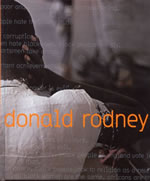Doublethink: The Art of Donald Rodney
Edited by Richard Hylton
Texts by Stuart Hall, Eddie Chambers and Virginia Nimarkoh
Edited by Richard Hylton
Published by Autograph (ABP), 2003.
More +Doublethink is the first comprehensive and in-depth survey of the artist Donald Rodney’s work. At the time of his death in 1998 at the age of 36, Rodney’s artistic career had spanned two decades and had produced some of the most engaging and innovative work by a British artist of his generation. Doublethink not only documents the career of a remarkable artist but also establishes the legacy of an artist that might otherwise remain overlooked. It represents an opportunity to re-evaluate the scope of Rodney’s practice, placing it at the heart of the artistic, social and political contexts in which it existed. It is evidence of a phenomenal career in which Rodney made work that was as relevant as it was potent.
From his gravitation towards Pan-Africanism as a student in the early eighties (which saw Rodney’s involvement with the likes of Marlene Smith, Keith Piper, Claudette Johnson and Eddie Chambers), to his presence in important exhibitions like ‘State of the Art’ (1987) and ‘TSWA’ (1990), through to his last solo exhibition ‘9 Night in Eldorado’ (1997), Rodney’s voracious appetite for knowledge and innovation meant that the churning out of formulaic work was not an option.
In charting the career of Donald Rodney, Doublethink presents not only the wide range of art forms that he employed in his practice but also the ways in which self-portraiture and the body were often conduits for wider social and political narratives. In the exhibition ‘The Atrocity Exhibition & Other Empire Stories’ (1986), the body referred to is one shaped by colonialism, post-World War II migration to Britain from the Caribbean and the inner city uprisings of the 1980s. Appropriating imagery from a wide range of historical and media sources, Rodney created a show of complex assemblages featuring sculpture, installation, photocopies, wall-based works and drawings. In this show, the presentation of historical and contemporary figures created a powerful resonance that was as resolute in its politics as it was uncompromising in its compassion…
Excerpt from Donald Rodney An Introduction by Richard Hylton
